Archived Water Damage Blog Posts
Flood: Can My Carpet Be Saved?
11/10/2022 (Permalink)
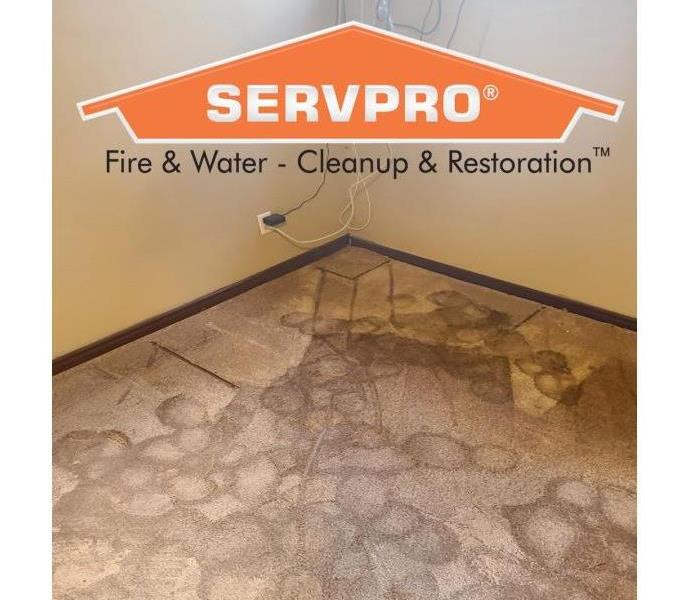 Basement flood in West Kelowna. Prior to mitigation the carpet was so saturated with water that footprints started to look like a design.
Basement flood in West Kelowna. Prior to mitigation the carpet was so saturated with water that footprints started to look like a design.
This is not a carpet design. This is a highly saturated carpet from a pipe burst in a basement wall; prior to our team extracting the water, removing the carpet pad, and placing drying equipment under & above the carpet.
During a flood in your home, many homeowners may wonder if their carpet can be saved.
The age and quality of the carpet and pad, as well as the category of water that flooded in the home is a key factor. In the restoration industry, we classify floodwater into three main categories.
Cat 1: Clean water- from a broken pipe or rainwater that has not mixed with any contaminants.
Cat 2: Greywater- is contaminated. This includes overflow from washing machines, dishwashers, toilet overflows with no solid matter, etc.
Cat 3: Blackwater- is highly contaminated. Examples include sewage, toilet backflows and weather disasters.
The water mitigation process should begin as soon as possible in any flooding event. Otherwise, the carpet can suffer permanent damage. To have a better chance of saving the carpet, contact a restoration professional immediately. We have the tools and expertise to extract, sanitize and dry the flooded carpet effectively.
In most Category 1 & 2 flooding, we can bring carpets back to life. The goal is not to replace but to restore.
A shop vacuum, towels, and home fans are no comparison for professional extraction and drying equipment. Every water damage situation is very different. Call the experts at SERVPRO. We are “Faster to Any Sized Disaster” and our goal is to have your home “Like It Never Even Happened”
Ice Dam: Signs & Prevention
2/7/2022 (Permalink)
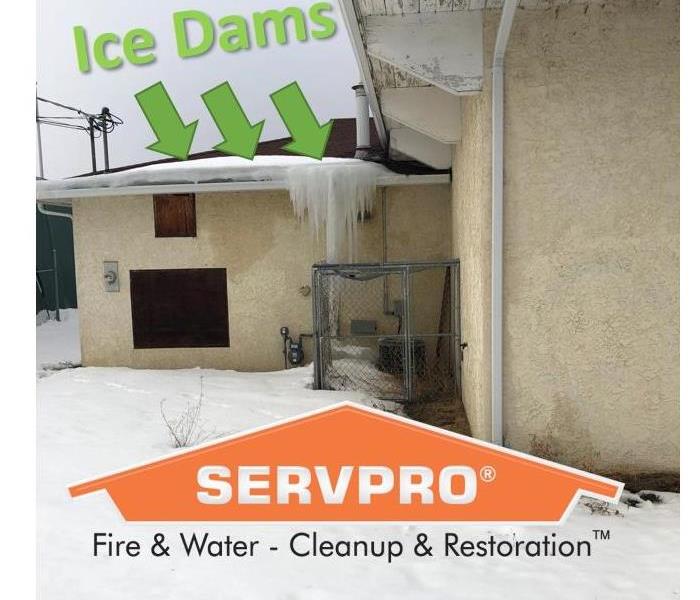 Extensive ice damming on a commercial building in West Kelowna, BC
Extensive ice damming on a commercial building in West Kelowna, BC
Those stunning icicles hanging from your roof may give your home a picturesque wintery look, but they could also be telling you that something is wrong. Icicles can be the first sign that an ice dam is present or is forming on your roof.
Ice dams prevent melting snow from escaping properly through eavestroughs and downspouts.
As standing water collects behind the ice dam, it will have nowhere to go except beneath shingles. Water underneath roof shingles may refreeze and expand as temperatures cool, which can make them break or detach. Water can then pour into your home causing water damage to drywall, framing, insulation, etc. Ice Dams can also cause extensive damage to your exterior (shingles, roof, gutters, downspouts, etc.) Not only can all these damages be costly to also poses a danger to people below.
Signs of an Ice Dam:
- Icicles on your roof
- Dark-coloured icicles
- New water-stains on your ceilings
- Different type or areas of melted snow on your roof compared to neighbors
- Dams (mounds of ice running along the edge of your roof)
Prevention:
- The best way to prevent ice damming is to properly insulate and ventilate your attic. If you are unsure if your home is adequately insulated and/or ventilated seek a professionals help to ensure the job is done right.
- Keep on top of snow removal from your roof after large snow falls. There is also chemical de-icers available in most hardware stores that can be place on your roof.
- Fall maintenance: Inspect your roof for damage, cracks, missing shingles and have any issues repaired. Clear out debris from your gutters
If you experience water damage or flooding in your home from ice damming call us today to properly access the damage and begin the restoration process.
Dishwashers: Maintenance Required
2/5/2021 (Permalink)
 Drying hardwood flooring from a dishwasher leak with our SERVPRO Dri Eaz floor mat system & dehumidifier in Kelowna, BC.
Drying hardwood flooring from a dishwasher leak with our SERVPRO Dri Eaz floor mat system & dehumidifier in Kelowna, BC.
Over the year’s dishwashers have become an essential home appliance. They make our lives easier, save water, and stop us from having to wash dishes by hand.
Dishwashers are more energy-efficient and environmentally friendly than handwashing. Certified dishwasher use up to 12% less energy and 30% less water on average. Using a dishwasher can save 380 litres of water a week, when you use it every night instead of handwashing. That's over almost 19,000 litres in a year.
As much as we love our dishwashers, they can cause us some major issues if they are not regularly inspected and maintained. Did you know that 30% of water damage in residential homes are caused by appliance failure?
To avoid future water damage and/or large appliance repair bills you need to regular inspect, clean and complete maintenance on your dishwasher. Follow these simple steps to avoid possible water damage and extend the life of your appliance:
- Ensure you dishwasher is on a level surface
- Check for leaks:
- Even if there is no obvious wear or leaks, replace hoses every five years. Use a reinforced steel-braided hose, as they are less likely to fail
- Inspect & Clean spinning arms:
- Check to make sure that the arms spin correctly and clean out any debris that has accumulated inside the holes
- Clean edges, exterior & gasket:
- Edges around the door do not get washed during a regular cycle and can end up with lots of spills and pieces of food debris
- Unclog and clean the drain/filter:
- At the very bottom of your dishwasher is the drain and filter, and this area can be a common place for food debris and buildup which can eventually cause a clog. On a regular basis, you should be disassembling your drain to remove debris. Here’s how you can do this:
- Locate your owner's manual and figure out what kind of filter your dishwasher has. If it's a manual filter, you will need to take it out and wash it
- Unplug the dishwasher
- Take out the screws and remove the cover
- Clean out larger pieces by hand
- Clean out smaller deposits with a brush or cloth
- Wash filter
- Reassemble
- Run a short cycle with white vinegar or an approved dishwasher cleaning agent
If you experience a dishwasher leak, time is of the essence to reduce damage. Our team is available 24/7 for emergency services.
The Importance of Drying & Dehumidification
8/10/2020 (Permalink)
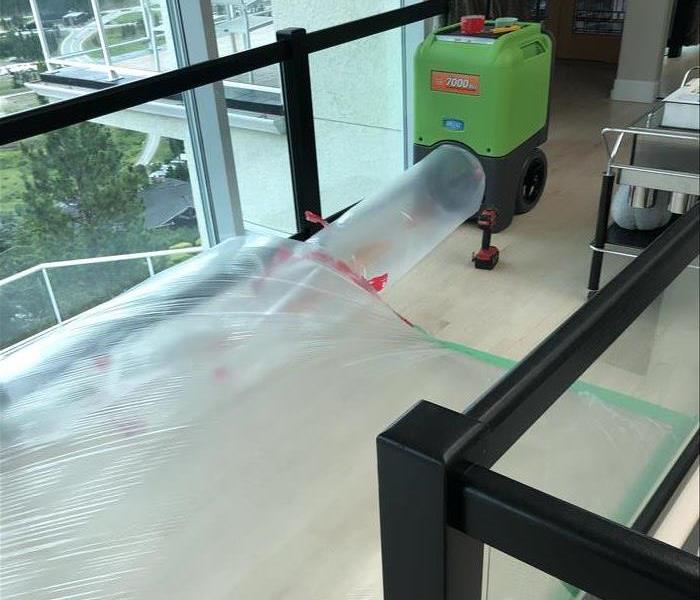 Drying flooring using SERVPRO's advanced equipment in a home in West Kelowna, BC
Drying flooring using SERVPRO's advanced equipment in a home in West Kelowna, BC
Once your home has experienced water damage, just removing the visible water does not eliminate all of the moisture. Water can pool behind walls & floors, and soak into porous material.
Majority of your home is made porous materials. Wood, drywall, flooring, and other items may appear to be dry after water removal, but in fact they retain a significant amount of water. If this water is not addressed materials can warp, swell, or create an ideal environment for mold to grow, causing even more significant damage to your property. Mold can start growing within 48 hours and cause structural damage down the road, as well as potentially causing health issues to those living in your home.
Consider water in 3 states: standing, absorbed, and evaporated. During and after a water emergency, all three of these states are present. Once the standing water has been removed, drying and dehumidifying need to follow.
With SERVPRO’s moisture detection equipment, we are able to identify all affected areas. This allows us to strategically place our drying & dehumidification equipment for maximum effectiveness, removing both the visible and non-visible moisture.
SERVPRO of Kelowna’s Water Drying Process:
Unwanted Water In Your Home? 5 Steps To Take To Prevent Further Damage
5/5/2020 (Permalink)
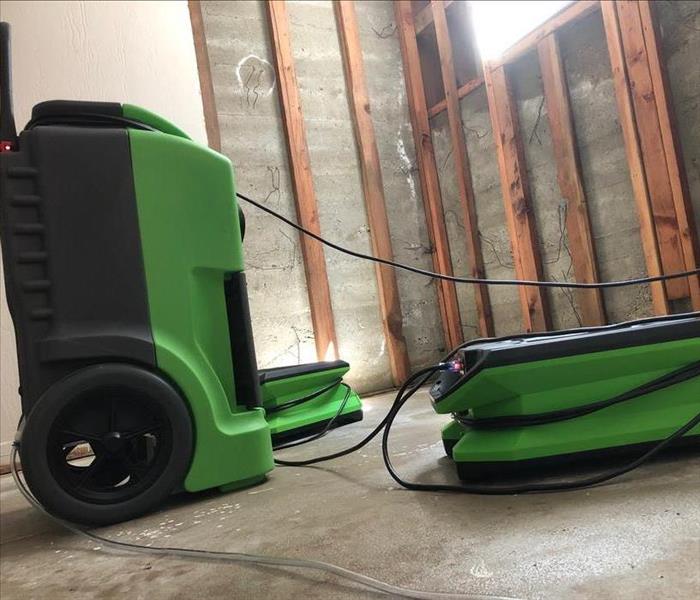 Professional water drying equipment set up in a home that recently experienced water damage.
Professional water drying equipment set up in a home that recently experienced water damage.
Flooding can be the result of weather or home issues, including plumbing failures. Unwanted water in your home can be very traumatic and overwhelming.
Here are 5 steps to take when you have unwanted water in your home:
- Stop the Water -Unless the flooding is due to an act of nature, find the source of the water and turn it off. The fastest way to stop water is to turn off the main water valve.
- Turn Off the Electricity -Turn off electrical breaker
- Take pictures - Document, document, document! -Before any restoration begins ensure you document the damage and your belongings for insurance purposes.
- Call SERVPRO - SERVPRO can handle the water removal, structural drying, and any mold remediation. Time is of the essence when dealing with water! Calling in the professionals to inspect the damage and begin the drying process can save your belongings, as well as significantly reduce damage and restoration/repair costs. (Not to mention prevent mold growth)
- Call your insurance company to begin the claims process.
In addition, the Canadian Red Cross has a great article about what to do before, during and after a flood caused by weather: https://www.redcross.ca/how-we-help/emergencies-and-disasters-in-canada/types-of-emergencies/floods
Protect your home from water disasters!
12/19/2019 (Permalink)
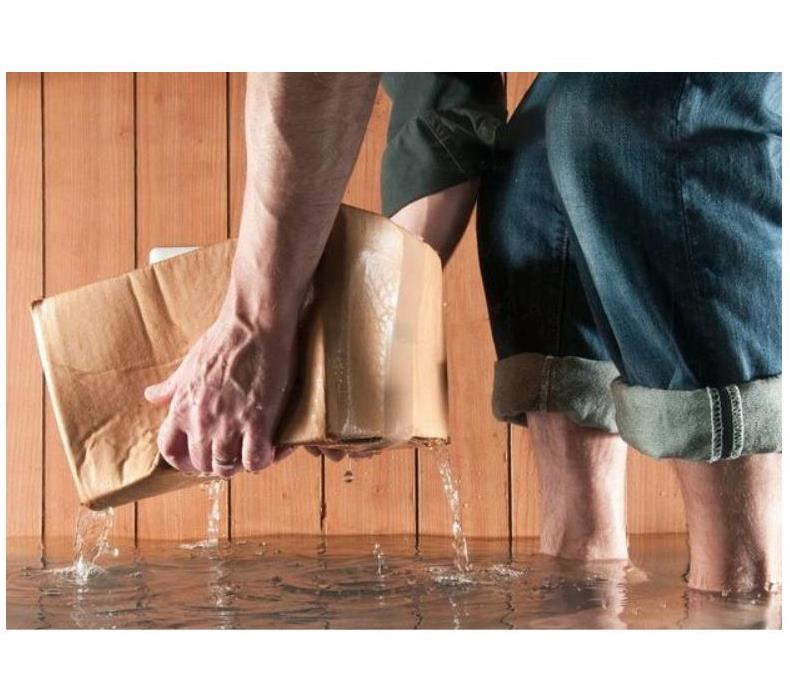 Flooded basement (PM Images / Getty Images)
Flooded basement (PM Images / Getty Images)
Water damage is one of the most common and costly disasters your home can experience. Protect your most important asset against water damage. In the case of an emergency call SERVPRO Kelowna at 250-899-9789 and follow these tips until we arrive https://www.SERVPROkelowna.com/water-damage-tips
Properly maintaining your home is the best ways to prevent water damage/disasters.
- Know the location of the main water shut-off valve in your home.
- Install an emergency pressure release valve in your plumbing system.
- Inspect all appliance hoses and faucets semi annually
- Inspect showers, tubs and sinks on a regular basis
- Check plumbing and heating pipes.
- If you're heading on vacation, have a friend or family member checking on your home and shut off the water supply to the washing machine before you leave
- Check for cracks in your basement foundation and floors.
And remember to protect your treasured memories before disaster happens. Store your valuables and memorabilia in waterproof bins or fire safes. Keep them stored on shelving and off the floor.
Time is key in the event of water leaks or disasters. There is a water damage
 Basement flood in West Kelowna. Prior to mitigation the carpet was so saturated with water that footprints started to look like a design.
Basement flood in West Kelowna. Prior to mitigation the carpet was so saturated with water that footprints started to look like a design.

 24/7 Emergency Service
24/7 Emergency Service



